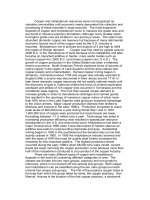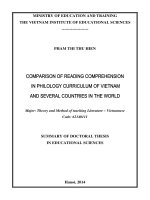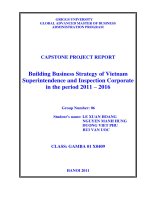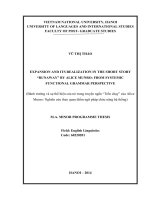Groups merging and groups disbanding in the internet
Bạn đang xem bản rút gọn của tài liệu. Xem và tải ngay bản đầy đủ của tài liệu tại đây (4.04 MB, 95 trang )
GROUPS MERGING AND GROUPS DISBANDING
IN THE INTERNET
ROBIN
(B. Comp (Hons)., National University of Singapore, 2002)
A THESIS SUBMITTED
FOR THE DEGREE OF MASTER OF SCIENCE
DEPARTMENT OF COMPUTER SCIENCE
NATIONAL UNIVERSITY OF SINGAPORE
2003
Summary
Although IP Multicast has been proposed for more than a decade, its deployment is
still limited to network domains under single administrative control. In addition, IP
Multicast communication model is largely limited to intra-group communication,
where a host is allowed to become member of a group to send or receive from the
group. IP Multicast does not provide a service for a whole group to become member of
the group to facilitate inter-groups communication.
A novel method is proposed to provide groups merging and groups disbanding to
support group-to-group communication in the Internet. The proposed solution is
designed to work without modifying IP Multicast routing protocols or changing the
existing Internet Group Management Protocol (IGMP). It does not relying on multicast
support from routers. Therefore, it can be easily deployed in the Internet.
This solution facilitates more creative development of groupware applications. Some
potential applications of the solution include: (1) managing group interactions in a
dynamic Computer Supported Cooperative Work (CSCW) environment such as elearning, (2) dynamic dissemination of notifications in publish/subscribe system, (3)
supporting heterogeneous QoS management of multimedia streams encoded with a
layered coding scheme.
An architecture to support groups merging and groups disbanding in the Internet called
Application Layer Connection Management Framework has been proposed. This
architecture consists of two main components: Connection Manager and Connection
i
Management System. Connection Manager is a distributed component for keeping
track of group memberships in its immediate multicast-island, bridging each group in
its immediate multicast-island to its respective group in other multicast-islands and
managing request to merge/disband a group to/from another group. Connection
Management System is formed by interconnected Connection Managers across
multiple multicast-islands for exchanging control information and forwarding data.
Protocols for handling join message, join status expiration, bridge message, bridge
status expiration, merge message and disband message have been designed. These
protocols are explained with the help of flow diagrams.
A prototype has been implemented successfully to demonstrate the feasibility of the
proposed solution. The implemented prototype has demonstrated the groups merging
and groups disbanding capabilities in the Internet. Performance evaluation results have
shown that the implemented prototype manages to perform reasonably well.
ii
Acknowledgement
I would like to express my sincere thanks to my project supervisor, Dr. Pung Hung
Keng, for his guidance, valuable discussions and encouragement throughout my
research work towards this thesis. His valuable feedback has helped me to improve the
thesis in many ways.
I would also like to thank my project team-mates. Special thanks go to Suthon SaeWong and Koh Kwang Yong for their willingness to take time to discuss research
possibilities with me. I am thankful to Chaiwat Sriyuenyong, An Liming and Chen
Xiaodong for their encouragement. I enjoyed all the discussions we had in various
topics.
Finally, I would like to thank all the members of Network Systems and Services
Laboratory.
iii
Table of Contents
CHAPTER 1 INTRODUCTION ................................................................................. 1
1.1 MOTIVATION .......................................................................................................... 1
1.2 OBJECTIVE ............................................................................................................. 4
1.3 GROUPS MERGING AND GROUPS DISBANDING SEMANTIC ..................................... 5
1.4 POTENTIAL APPLICATION ....................................................................................... 7
1.4.1 Managing Group Interactions in E-learning Environment ........................... 7
1.4.2 Dissemination of Notifications in Publish/Subscribe System ........................ 8
1.4.3 Supporting Heterogeneous QoS Management of Multimedia Streams ....... 10
1.5 THESIS OUTLINE .................................................................................................. 12
CHAPTER 2 BACKGROUND AND RELATED WORKS ................................... 14
2.1 BACKGROUND ...................................................................................................... 14
2.1.1 IP Multicast.................................................................................................. 14
2.1.2 Internet Group Management Protocol......................................................... 15
2.1.3 OCTOPUS.................................................................................................... 16
2.2 RELATED WORKS ON GROUPS MERGING AND DISBANDING ................................ 18
CHAPTER 3 CONCEPTS OF GROUPS MERGING AND GROUPS
DISBANDING ............................................................................................................. 21
3.1 DEFINITION .......................................................................................................... 21
3.1.1 Group Definition.......................................................................................... 21
3.2 GROUPS MERGING IN MULTICAST-SUPPORTED NETWORK .................................. 22
3.3 GROUPS MERGING IN THE INTERNET .................................................................... 25
3.3.1 Individual end host join a group.................................................................. 25
3.3.2 Group merge to another group .................................................................... 28
CHAPTER 4 ARCHITECTURE OF APPLICATION LEVEL CONNECTION
MANAGEMENT FRAMEWORK............................................................................ 31
4.1 ARCHITECTURE COMPONENTS ............................................................................. 31
4.2 CONNECTION MANAGER ...................................................................................... 32
iv
4.2.1 Modules of Connection Manager................................................................. 33
4.2.2 Connection Manager Operations ................................................................ 34
4.3 CONNECTION MANAGEMENT SYSTEM ................................................................. 35
CHAPTER 5 CONNECTION MANAGEMENT PROTOCOL ............................ 38
5.1 CONNECTION MANAGEMENT PROTOCOL MESSAGES ........................................... 38
5.1.1 Join Message................................................................................................ 38
5.1.2 Bridge Message............................................................................................ 39
5.1.3 Merge Message ............................................................................................ 41
5.1.4 Disband Message ......................................................................................... 42
5.2 CONNECTION MANAGEMENT PROTOCOL ............................................................. 42
5.2.1 Handling of Join Message ........................................................................... 42
5.2.2 Handling of Join Status Expiration.............................................................. 45
5.2.3 Handling of Bridge Message ....................................................................... 46
5.2.4 Handling of Bridge Status Expiration.......................................................... 49
5.2.5 Handling of Merge Message........................................................................ 50
5.2.6 Handling of Disband Message..................................................................... 52
CHAPTER 6 IMPLEMENTATION AND EVALUATION ................................... 55
6.1 IMPLEMENTATION ................................................................................................ 55
6.1.1 Implementation of Connection Manager ..................................................... 55
6.1.2 Implementation of Connection Management System ................................... 57
6.2 EVALUATIONS ...................................................................................................... 59
6.2.1 Functionality Test ........................................................................................ 59
6.2.2 Performance Test ......................................................................................... 61
CHAPTER 7 DISCUSSION....................................................................................... 76
7.1 SCALABILITY ISSUE .............................................................................................. 76
7.2 RELIABILITY ISSUE ............................................................................................... 78
7.2.1 Fault Tolerance Capability.......................................................................... 78
7.2.2 Reliable Control Channel ............................................................................ 79
7.3 PLACEMENT OF CONNECTION MANAGER ............................................................. 80
7.4 SECURITY ISSUE ................................................................................................... 80
7.5 PARTIAL GROUPS MERGING ................................................................................. 81
CHAPTER 8 CONCLUSION AND FUTURE WORK........................................... 82
v
List of Tables
TABLE 6-1: MERGE LATENCY AND DISBAND LATENCY ................................................. 63
TABLE 6-2: LATENCY WITHOUT GROUPS MERGING AND LATENCY WITH GROUPS
MERGING FOR APPLICATION LEVEL AND NETWORK LEVEL CONNECTION MANAGER
............................................................................................................................... 67
TABLE 6-3: LATENCY WITHOUT GROUPS MERGING, LATENCY WITH GROUPS MERGING
FOR APPLICATION LEVEL CM FOR INTER MULTICAST ISLAND GROUPS MERGING AND
LATENCY WITH GROUPS MERGING FOR NETWORK LEVEL CM FOR DISTRIBUTED
NETWORK ............................................................................................................... 72
vi
List of Figures
FIGURE 1-1: A TYPICAL NON-MULTICAST-SUPPORTED NETWORK WITH MEMBERS OF
GROUP X AND GROUP Y ........................................................................................... 3
FIGURE 1-2: INITIAL STATE BEFORE GROUPS MERGING OPERATION.................................. 5
FIGURE 1-3: RESULT OF GROUP A MERGES TO GROUP B .................................................. 6
FIGURE 1-4: BOTH MEMBERS OF GROUP A AND GROUP B CAN RECEIVE PACKETS FROM
EACH OTHER ............................................................................................................. 6
FIGURE 1-5: NEWS TOPIC HIERARCHY .............................................................................. 9
FIGURE 1-6: MULTIPLE COPIES OF SAME ARTICLE ARE SENT WHEN TRADITIONAL IP
MULTICAST IS USED ................................................................................................. 9
FIGURE 1-7: ONLY ONE COPY OF THE LINUX ARTICLE IS SENT WHEN GROUPS MERGING
CAPABILITY IS UTILISED ......................................................................................... 10
FIGURE 1-8 VIDEO STREAM ENCODED WITH A LAYERED CODING SCHEME ..................... 11
FIGURE 1-9 SERVING HETEROGENEOUS QOS BY LEVERAGING ON GROUPS MERGING
CAPABILITY ............................................................................................................ 12
FIGURE 2-1: OCTOPUS ARCHITECTURE ....................................................................... 17
FIGURE 3-1: A TYPICAL MULTICAST-SUPPORTED NETWORK WITH MEMBERS OF GROUP X
AND GROUP Y
........................................................................................................ 22
FIGURE 3-2: THE COST OF CURRENT IP MULTICAST IN SENDING IGMP MEMBERSHIP
REPORTS BY EACH MEMBERS OF GROUP X WHEN JOINING GROUP Y ...................... 23
FIGURE 3-3: GROUPS MERGING IN A MULTICAST-SUPPORTED NETWORK ........................ 24
FIGURE 3-4: THE PROCEDURE OF AN END HOST JOINING A NEW GROUP .......................... 26
FIGURE 3-5: THE PROCEDURE OF AN END HOST JOINING TO AN EXISTING GROUP ........... 27
FIGURE 3-6: THE PROCEDURE FOR GROUPS MERGING IN THE INTERNET ......................... 28
FIGURE 4-1: ARCHITECTURE OF APPLICATION LEVEL CONNECTION MANAGER
FRAMEWORK.......................................................................................................... 32
FIGURE 4-2: STRUCTURE OF JOIN_LIST........................................................................... 33
FIGURE 4-3: STRUCTURE OF AN ENTRY IN BRIDGE_TABLE ............................................. 34
FIGURE 4-4: STRUCTURE OF AN ENTRY IN MERGE_TABLE .............................................. 34
vii
FIGURE 4-5: MULTIPLE MULTICAST CHANNELS ON CONNECTION MANAGEMENT SYSTEM
............................................................................................................................... 36
FIGURE 5-1: JOIN MESSAGE FORMAT .............................................................................. 38
FIGURE 5-2: BRIDGE MESSAGE FORMAT ......................................................................... 40
FIGURE 5-3: MERGE MESSAGE FORMAT ......................................................................... 41
FIGURE 5-4: DISBAND MESSAGE FORMAT ...................................................................... 42
FIGURE 5-5: LOGIC FOR HANDLING JOIN REQUEST BY CM ............................................ 43
FIGURE 5-6: LOGIC FOR HANDLING EXPIRED JOIN STATUS BY CM ................................ 46
FIGURE 5-7: LOGIC FOR HANDLING BRIDGE REQUEST BY CM ........................................ 48
FIGURE 5-8: LOGIC FOR HANDLING EXPIRED BRIDGE STATUS BY CM ............................ 49
FIGURE 5-9: LOGIC FOR HANDLING GROUP MERGE REQUEST BY CM ............................. 51
FIGURE 5-10: LOGIC FOR HANDLING GROUP DISBAND REQUEST BY CM........................ 53
FIGURE 6-1: CONNECTION MANAGER API ACCESSIBLE TO END HOST............................ 56
FIGURE 6-2: OVERLAYSOCKET INTERFACE .................................................................... 58
FIGURE 6-3: SETUP FOR FUNCTIONALITY TESTING ......................................................... 59
FIGURE 6-4: SETUP FOR TESTING ON MERGE LATENCY AND DISBAND LATENCY OF
APPLICATION LEVEL CONNECTION MANAGER ...................................................... 62
FIGURE 6-5: SETUP FOR TESTING ON MERGE LATENCY AND DISBAND LATENCY OF
NETWORK LEVEL CONNECTION MANAGER ........................................................... 63
FIGURE 6-6: CM PROCESSING DELAY OF APPLICATION LEVEL CM AND NETWORK
LEVEL CM IN THE CASE OF INTRA MULTICAST-ISLAND GROUPS MERGING ............. 68
FIGURE 6-7: SETUP USED FOR MEASURING CM PROCESSING DELAY FOR INTER
MULTICAST-ISLANDS GROUPS MERGING ................................................................. 69
FIGURE 6-8: SETUP FOR MEASURING LATENCY WITH GROUPS MERGING OF NETWORK
LEVEL CONNECTION MANAGER IN DISTRIBUTED NETWORK .................................. 70
FIGURE 6-9: APPLICATION LEVEL CM PROCESSING DELAY IN THE CASE OF INTER
MULTICAST-ISLAND GROUPS MERGING AND APPLICATION LEVEL CM PROCESSING
DELAY IN THE CASE OF DISTRIBUTED NETWORK GROUPS MERGING ....................... 73
FIGURE 6-10: PACKETS TRAVELLING FROM SENDER TO RECEIVER HAVE TO GO THROUGH
ADDRESS TRANSLATION ONCE IN INTRA MULTICAST-ISLAND GROUPS MERGING .... 75
FIGURE 6-11: PACKETS TRAVELLING FROM SENDER TO RECEIVER HAVE TO GO THROUGH
ADDRESS TRANSLATION TWICE IN INTER MULTICAST-ISLANDS GROUPS MERGING .. 74
FIGURE 7-1: PACKETS DUPLICATION DUE TO HAVING MORE THAN ONE CM TO DO
PACKETS FORWARDING .......................................................................................... 77
viii
Abbreviation
API
Application Programming Interface
CM
Connection Manager
CMS
Connection Management System
CSCW
Computer Supported Cooperative Work
DPF
Dynamic Protocol Framework
IANA
Internet Assigned Numbers Authority
IEEE
Institute of Electrical and Electronics Engineers
IGMP
Internet Group Management Protocol
ISP
Internet Service Provider
LAN
Local Area Network
QMan
QoS Management Framework
QoS
Quality of Service
RTP
Real-time Transport Protocol
SLM
Service Locating Manager
SM
Stream Manager
TCP
Transmission Control Protocol
UDP
User Datagram Protocol
ix
Chapter 1 Introduction
CHAPTER 1
INTRODUCTION
Although IP Multicast has been proposed for more than a decade, its deployment is
still limited to network domains under single administrative control. In addition, IP
Multicast communication model is largely limited to intra-group communication,
where a host is allowed to become member of a group to send or receive from the
group. IP Multicast does not provide a service for a whole group to become member of
the group to facilitate inter-groups communication.
A novel method is developed to merge and disband groups in the Internet, which
makes inter-groups communication more pervasive. It is designed to work without
modifying IP Multicast routing protocols or changing the existing Internet Group
Management Protocol (IGMP). It can operate without depending on multicast support
from routers. A prototype has been implemented successfully to demonstrate the
feasibility of the proposed method. The proposed solution fills the necessary gap in the
existing IP Multicast, where the lack of graceful groups merging and groups
disbanding in the Internet presents an obstacle for more creative usage of group-togroup applications.
1.1 M OTIVATION
Even though the IP Multicast [1] has been available for more than a decade, it is yet to
be widely deployed. IP Multicast requires each host to have access to a native
multicast routing service. While intra-domain IP Multicast service (within network
domains under single administrative control) is widely available, this is not the case for
1
inter-domain IP Multicast. Many Internet Service Providers (ISP) are still reluctant to
provide multicast routing service [2] because (1) IP Multicast service is hard to
maintain and manage; (2) pricing model for multicast service is not clear, should the
source or the receivers be charged?
In addition to deployment problem, IP Multicast also suffers from scalability problem
as it requires multicast routers to maintain forwarding state for every multicast tree.
Forwarding state grows as the number of multicast group increases.
Today’s group communication is largely limited to a host sending data to a group or
receiving data from a group (intra-group communication). There is no communication
service that allows a group sending data to another group or receiving data from
another group (inter-group communication). The lack of support for group-to-group
communication is largely due to the limitation of current IP Multicast which allows a
host to become member of a group, but does not provide a service for a whole group to
become members of the group.
1
Solution to provide groups merging and groups disbanding capabilities has been
proposed in previous work [3]. However, the groups merging and groups disbanding
capabilities it provides has been limited to within a multicast-island. A multicast-island
is defined here as a network of any size that supports IP Multicast. It can be as small as
an Ethernet segment, a campus network or a wide area network. The boundary of an
island is the furthest extent an IP Multicast packet can travel in the network.
1
Throughout this thesis, the term “groups merging” is used to refer to the action of a group joining
another group as a whole unit and the term “group disbanding” is used to refer to the action of a group
leaving another group.
2
Figure 1-1 illustrates a typical non-multicast-supported network where there are
members of group X and group Y. It is a non-multicast-supported network as the
network consists of routers that are incapable of forwarding multicast packets. Group
X has members xi residing in subnet 2, while group Y has members yi found in subnet 4.
Rij denotes a non-multicast router that bridges connection between subnet i and subnet
j. Each subnet in the network forms a multicast-island.
Figure 1-1: A typical non-multicast-supported network with members of group X and
group Y
In this setup, let us suppose group X in subnet 2 wishes to receive data from group Y in
subnet 4 in addition to its own data. There is no way to achieve this in the current IP
Multicast as routers connecting subnet 2 and subnet 4 are not capable of forwarding
multicast packets. Thus, leveraging current IP Multicast to achieve the effect of groups
merging in non-multicast-supported network is practically impossible. Our proposed
solution makes groups merging in non-multicast-supported network possible.
The limitations and constraints described above have hold back the development of
creative group communication applications. Clearly, there is a need to provide groups
3
merging and groups disbanding capabilities beyond multicast-island to enable groupto-group communication in the Internet.
1.2 O BJECTI VE
The primary objective of this thesis is to extend groups merging and groups disbanding
capabilities beyond multicast-island. We propose a complete solution to provide
groups merging and groups disbanding capabilities, both within and beyond a
multicast-island.
Our proposed solution provides a way for a group to join to another group as a whole
unit and to leave from the group when needed. It is designed to work without
modifying the existing IP Multicast routing protocols [4][5][6][7] or changing the
existing Internet Group Management Protocol (IGMP) [8][9][10]. It can even operate
without depending on multicast support from the router. Thus, it can be deployed
easily in the Internet, bypassing the deployment issue of IP Multicast.
Our proposed solution can cooperate with modified router in the previous work or
operate on its own to provide groups merging and groups disbanding capabilities
within a multicast-island.
Our proposed solution extends groups merging and groups disbanding capabilities
beyond multicast-island by leveraging on overlay multicast technology. Overlay
multicast, which allows replication and forwarding of data packets to be done in a
virtual layer build above the infrastructure network, implements IP Multicast in
application layer without support from multicast routers.
4
Our proposed solution also enhances the reliability of groups merging and groups
disbanding. This can be achieved through the usage of reliable protocol such as
Transmission Control Protocol (TCP) [11] for overlay multicast.
1.3 G ROUPS M ERGING
AND
G ROUPS D I SBANDI NG S EMANTI C
Groups merging operation can be explained in terms of subset operation in set theory.
Suppose there are two multicast group A and B with members ai and bi respectively.
Initially, members of group A and group B receive only packets from its respective
group as shown in Figure 1-2.
Figure 1-2: Initial state before groups merging operation
When group A is merged to group B, group A becomes a sub group of group B. In
terms of set theory, this can be viewed as A ⊂ B. Members of group A receive
multicast packets sent to group B. However, members of group B do not receive
packets sent to group A. The effect of group A merges to group B is illustrated in
Figure 1-3.
5
Figure 1-3: Result of group A merges to group B
In Figure 1-3, members of group A receive packets sent to group B but members of
group B do not receive packets sent to group A. Sometimes, it is desired to have
members of group A to receive packets sent to group B and at the same time members
of group B can receive packets sent to group A as shown in Figure 1-4. This scenario
can be achieved by using two groups merging operations: (1) group A merges to group
B and (2) group B merges to group A.
Figure 1-4: Both members of group A and group B can receive packets from each
other
6
A cascading form of groups merging can be accomplished by treating a complex group,
a group that contains subgroup, as a single group and let this group merges to another
group.
Groups disbanding operation disbands one group from another group i.e. cancels the
effect of groups merging operation. Continuing from the point after group A merges to
group B; when group A is disbanded from group B, group A and group B return to their
initial states i.e. members of group A and group B only receive packets from their
respective group.
By using one message for merging to or disbanding from another group, a graceful
form of groups merging to share information and groups disbanding to return to the
form of separate groups is achieved.
1.4 P OTENTI AL A PPLICATION
The provision of groups merging and groups disbanding in the Internet allows
developers to create more innovative group communication applications. Potential
applications of the solution include: (1) managing group interactions in a dynamic
Computer Supported Cooperative Work (CSCW) environment such as e-learning, (2)
dynamic dissemination of notifications in publish/subscribe system, (3) supporting
heterogeneous QoS management of multimedia streams encoded with a layered coding
scheme.
1.4.1 Managing Group Interactions in E-learning Environment
In real-time collaborative e-learning activities such as group discussions, groups
merging and groups disbanding can be leveraged to manage interactions between
different groups.
7
Let’s suppose that there is an online discussion session on transport protocol topic.
Students are divided into two groups, one group discusses about Transmission Control
Protocol (TCP) and another group discusses about User Datagram Protocol (UDP).
After the students have discussed within their own group for some time, the course
lecturer wants to allow interaction between groups to compare TCP and UDP. This can
be achieved easily by leveraging on groups merging operation.
When the discussion to compare TCP and UDP is done, the lecturer can then disband
the merged group into their separated groups.
1.4.2 Dissemination of Notifications in Publish/Subscribe System
Publish/subscribe paradigm is a simple interaction model consisting of information
providers that publish events and information consumers who subscribe to events of
interest. A publish/subscribe system notifies subscribers as quickly as possible upon
the occurrence of relevant events.
In a subject-based publish/subscribe system, each event is classified based on topics.
Information providers are required to label each event with a topic and information
consumers subscribe to all events within a particular topic.
Since the introduction of IP Multicast, several subject-based publish/subscribe systems
that leverage on the IP Multicast to disseminate information have been proposed
[12][13]. In these systems, a multicast group is defined for each topic. Events that
match a particular topic are multicast to the multicast group assigned for the topic.
Using traditional IP Multicast for disseminating notifications runs into problem in the
area of complex subscriptions where one topic may be part of another topic. For
8
example, suppose there is an online news subscription system which allows subscriber
to subscribe to different news topic. The news topic hierarchy is shown in Figure 1-5.
Figure 1-5: News topic hierarchy
When an article on LINUX, which matches topic “All news”, “Technology news” and
“IT news”, is published to a publish/subscribe system leveraging on traditional IP
Multicast, three copies of the same LINUX article have to be sent, each for multicast
group of topic “All news”, “Technology news” and “IT news” as shown in Figure 1-6.
Figure 1-6: Multiple copies of same article are sent when traditional IP Multicast is
used
9
The usage of groups merging can help publish/subscribe systems to avoid sending
redundant copies of notifications. Using the groups merging capability, multicast
group of topic “IT news” can be merged to multicast group for “Technology news”
which in turn merged to multicast group for “All news”. The system only needs to
send the LINUX article to the multicast group of “All news”. Because of the groups
merging effect, this LINUX article is replicated to “Technology news” and “IT news”
multicast groups (as shown in Figure 1-7) only at the edge networks where subscribers
reside.
Figure 1-7: Only one copy of the LINUX article is sent when groups merging
capability is utilised
1.4.3 Supporting Heterogeneous QoS Management of Multimedia Streams
Groups merging and groups disbanding operations can be leveraged upon to serve
heterogeneous QoS based on layered coding scheme [14][15][16]. Layered coding is a
signal representation technique, in which the source data is partitioned into base layer
and enhancement layers. The base layer contains essential information for
reconstruction of the signal by the receiver. The enhancement layers contain
information that improves the quality of reception.
10
Suppose a video stream is encoded with a layered coding scheme into three layers:
base, enhancement1 and enhancement2. Each of these layers is streamed to a multicast
group as illustrated in Figure 1-8.
Figure 1-8 Video stream encoded with a layered coding scheme
Further assume that there are three classes of QoS: low, medium and high. Instead of
having to join the different multicast groups to receive video coding of the various
layers, the hosts can leverage on the merging capability by merging the appropriate
multicast groups to the groups they have joined initially. To receive high quality video,
hosts subscribe to multicast group F, which is created by merging multicast group A,
group B and group C to it, as shown in Figure 1-9.
By leveraging on groups merging and groups disbanding capabilities, dynamic QoS
adaptation can be provided. In Figure 1-9, hosts subscribe to multicast group E to
receive medium quality video stream can upgrade to high quality simply by merging
multicast group E to multicast group C. Similarly, they can downgrade to low quality
video stream by disbanding multicast group E from multicast group B.
11
!
Figure 1-9 Serving heterogeneous QoS by leveraging on groups merging capability
1.5 T HESIS O UTLINE
The remaining of the thesis is organised as follows.
Chapter 2 provides background on IP Multicast, Internet Group Management Protocol
and OCTOPUS middleware. In addition, related works on groups merging and
disbanding are discussed.
Chapter 3 explains the concepts of groups merging and groups disbanding. First,
definition of group is given followed by an overview of the solution to provide groups
merging and disbanding in various network environments.
Chapter 4 describes the architecture of application level connection management
framework. Main components of the architecture together with their functionalities are
explained.
12
Chapter 5 elaborates connection management protocols. Various message types and
their usages are described. Detail protocols for various operations are also explained
with flowcharts.
Chapter 6 shows the implementation of our prototype. Functional evaluation and
performance evaluation for several scenarios are described.
Chapter 7 discusses scalability, reliability, security, placement of Connection Manager
and partial groups merging issues and presents solutions to address the issues.
Finally, Chapter 8 presents some concluding remarks and highlights direction of future
development.
13
Chapter 2 Background and Related Works
CHAPTER 2
BACKGROUND
AND
RELATED WORKS
This chapter gives some background on IP Multicast, Internet Group Management
Protocol and OCTOPUS middleware. In addition, related works on groups merging
and groups disbanding are discussed.
2.1 B ACK GROUND
2.1.1 IP Multicast
Multicast is used to deliver data to multiple receivers from a single source or multiple
sources. It provides one-to-many and many-to-many communication; unlike unicast
which allows only one-to-one communication. Multicast delivers traffic to multiple
receivers efficiently in such a way that packets are not sent several times on a given
link.
There are two levels of multicast transmission: local multicast transmission and IP
Multicast transmission. Local multicast leverages on multicast capabilities of the
physical layer, e.g. Ethernet (IEEE 802.3) to deliver data to multiple receivers on a
local area network (LAN). IP Multicast is totally different. It requires the use of
multicast routers that are capable of managing multicast delivery tree and responsible
for forwarding multicast traffic across LANs.
IP Multicast group is identified by a single multicast IP address. Internet Assigned
Numbers Authority (IANA) has assigned Class D IP address space for IP Multicast. IP
Multicast group addresses fall in the range of 224.0.0.0 to 239.255.255.255.
14
IP Multicast group model is an open model. Any host can listen to a multicast group
and send to a multicast group without any authorisation. A source can send to a
multicast group regardless of whether it is a member of the group or not. Hosts that are
interested in receiving a particular multicast group data must join the group to receive
data sent to this group.
2.1.2 Internet Group Management Protocol
Internet Group Management Protocol (IGMP) is used by multicast routers to discover
the presence of group members on their directly attached LANs.
In IGMP Version 1 [8], there are two types of messages: Membership Report and
Membership Query. When a host wants to join a multicast group, it sends out an IGMP
Membership Report corresponding to the group that it wishes to receive to its local
multicast router. The multicast router periodically sends out an IGMP Membership
Query to discover active groups on its directly attached LANs. Hosts respond to IGMP
Membership Query by generating IGMP Membership Report for each group that they
are interested to join. When IGMP Membership Report is not received for a particular
group after three consecutive IGMP Membership Queries, the multicast router times
out the group and stops forwarding traffic directed toward that group.
IGMP Version 2 [9] is similar to Version 1. The main difference is the addition of
IGMP Membership Leave Report and IGMP Group Specific Membership Query. The
hosts can communicate to their local multicast router their intention to leave the group
by sending out an IGMP Membership Leave Report. The multicast router then sends
out an IGMP Group Specific Membership Query to check whether there are any
remaining hosts interested in receiving the traffic from this particular group. If there
are no replies, the multicast router times out the group and stops forwarding traffic
15









